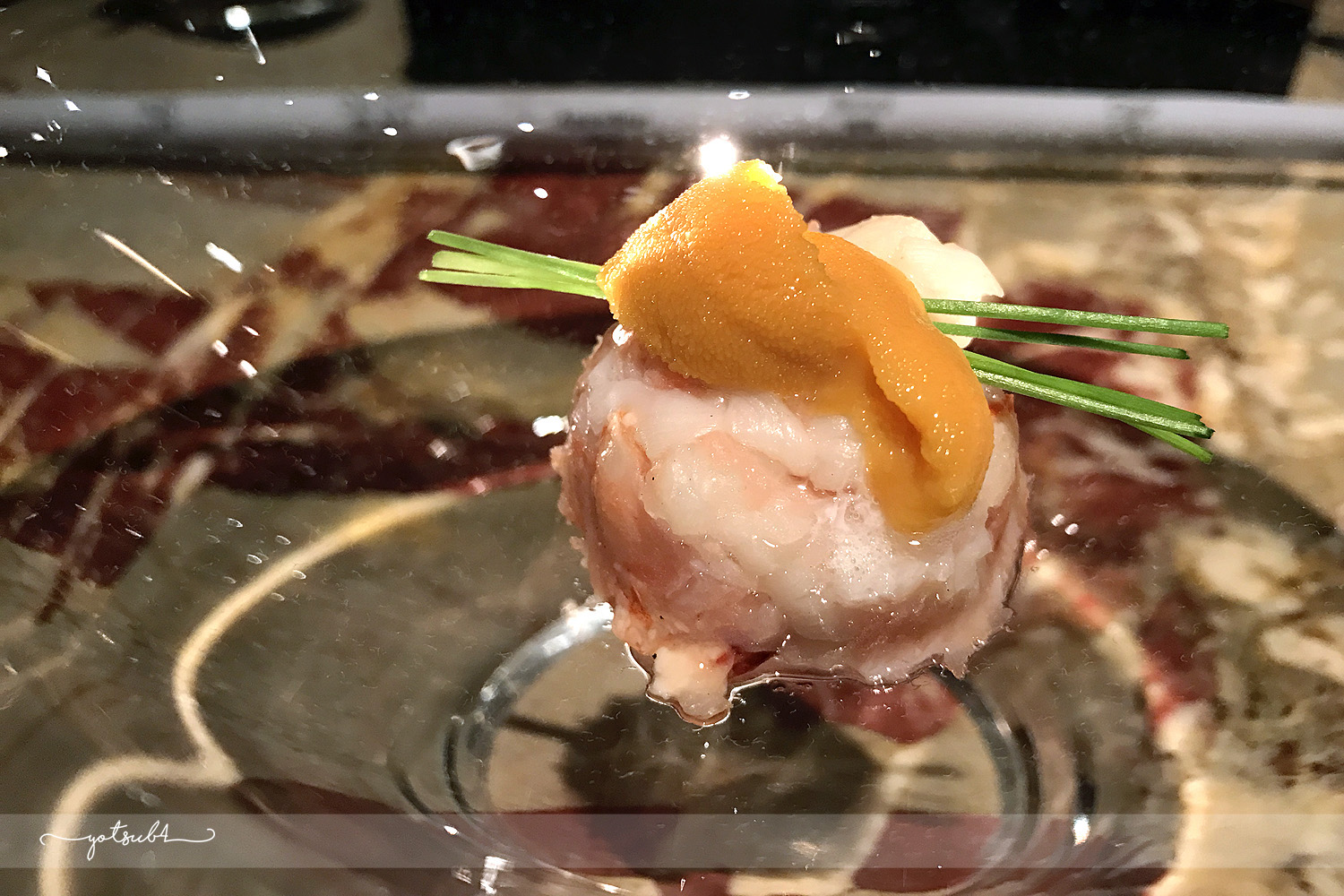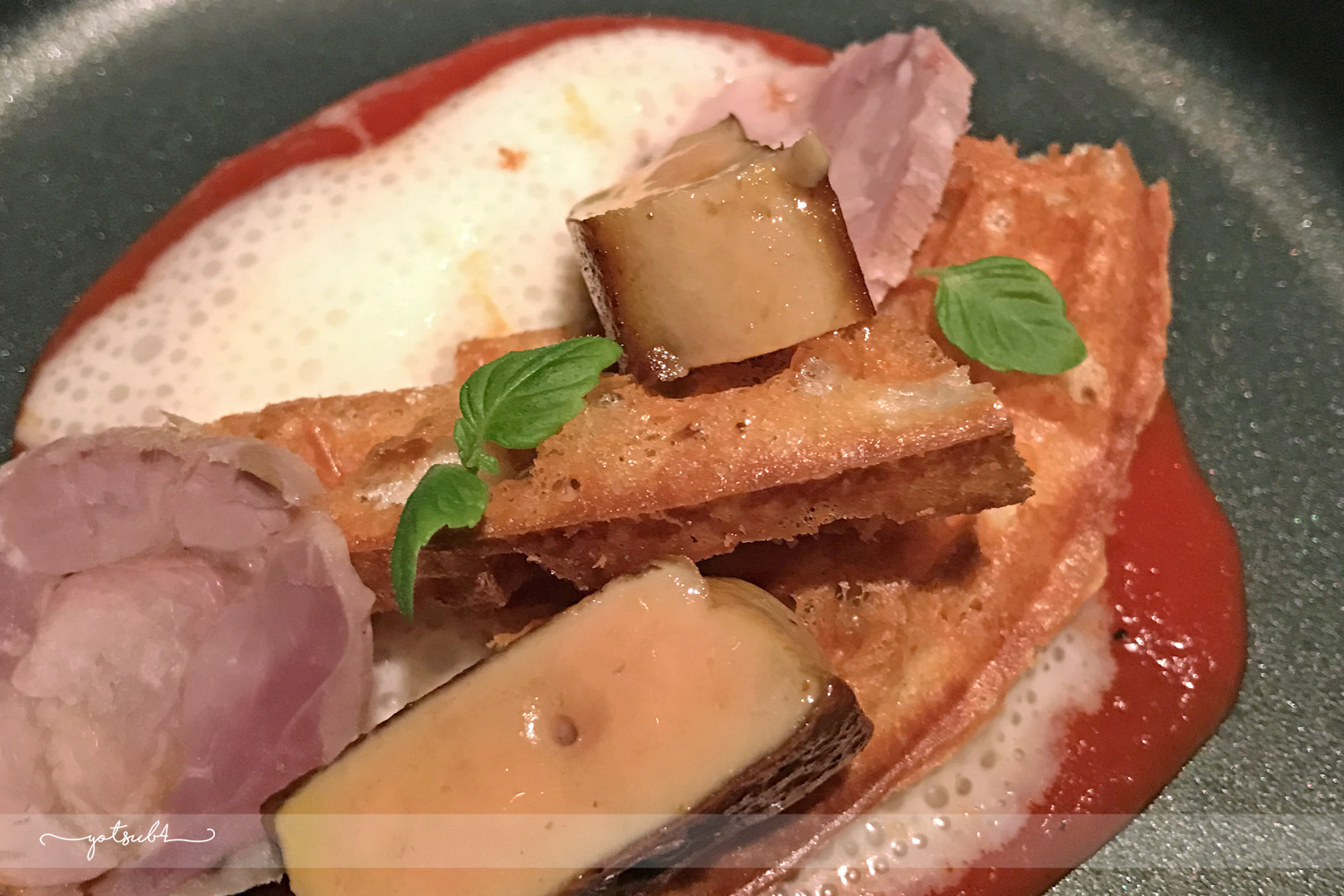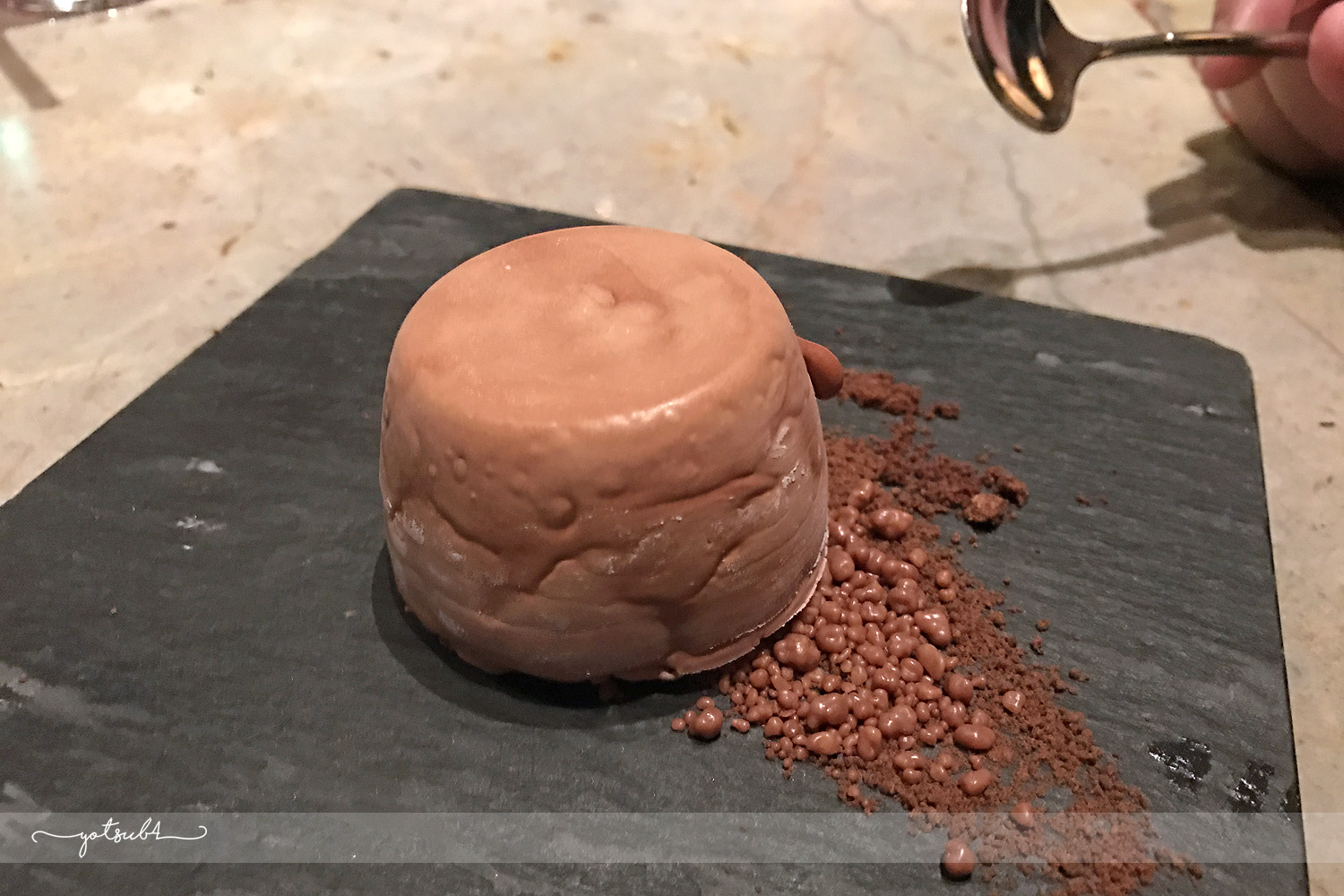Food Diary - Tapas Molecular Bar, Tokyo
 |
| Degustation: Onsen Tamago (orzo, parmesan) |
As mentioned in the Tokyo post, we dined at Tapas Molecular Bar, at the Mandarin Oriental Tokyo. The choice had been based on some blog reviews we'd seen, namely those on alifewortheating (Feb 2011, under Chef Jeff Ramsey), Kenneth Tiong Eats (Sep 2013 under Chef Koichi Hashimoto), That Food Cray (2 May 2014), Travel with Nano B. (Jan 2016); and Pineappleislands (July 2016). Unfortunately, 5 of those wonderful reviews with wonderful pictures were posted when TMB's kitchen was helmed by other chefs, so I'm not sure if there's even a point of comparison.
 |
| Chef Ngan Ping Chow and his sous-chef, Tapas Molecular Bar, Mandarin Oriental Tokyo |
Tapas Molecular Bar is now helmed by Hong Kong chef Ngan Ping Chow, who won his first Michelin star in December 2014 and trained under the executive chef Uwe Opocensky at the Mandarin Oriental Hong Kong (which we have also visited, but to have dimsum at Man Wah).
Right off the bat, we were presented with a toolbox full of tools and a measuring tape that revealed the menu. If anything, it was interesting but also signaled to me a concept-focused dining experience.
 |
| Our eating tools and the menu. |
Dinner started with a series of Japanese Delights: gunkan, nigiri and oshizushi. Each piece references a traditional sushi. But they're only about as traditional as their names and shapes.
The Gunkan references the gunkan-maki (軍艦巻) - in fact, it looked a teeny bit like the ikura sushi we've been eating at all the sushiya recently.... Only that the little orange spheres contained chicken eggs, topped with white truffle, and instead of nori, was a thin slice of cucumber. Then the Nigiri, which obviously references nigirizushi (握り寿司), looking very much like a nigirizushi with tarabagani as the topping... But nope, it was chicken, sitting on top of a compressed Waldorf salad. And finally the Oshi Sushi - the obvious nod to oshizushi (押し寿司), the less-seen pressed sushi... this one with veal terrine, topped with maguro. Not my cuppa but that's personal because I'm not a huge fan of aspic, and don't often appreciate meat-based terrine.
Sushi but not sushi. Hmm. Definitely something there, but not quite..... Flavour-wise, it was solid but these weren't particularly blow-your-mind combinations, and even seemed a bit traditional. Maybe I am expecting too much. The problem with labeling something "molecular gastronomy" is that it often comes loaded with expectation and hype.
 |
| Japanese Delights: Gunkan (eggs, white truffle), Nigiri (Waldorf, chicken), Oshi Sushi (veal, tuna) |
Next, Bonsai — a little tempura 'shroom growing in edible soil in a sugar pot! This one was delicious. Too bad it was only one mouthful bite!
 |
| Bonsai (leaf, roots) |
Then we had a Cigar, which was sous vide Iberico pork with apple and cucumber, rolled up in crispy skin and smoked. The look was finished with a side of crushed black sesame and tapioca flour, making up the ash, and a dab of smokey duck sauce. In terms of how it looks, it's visually stunning; it really looks like a cigar, and is very photogenic, Instagram-worthy.
But the surprise here was the entire concoction also tasted like Peking duck. Yes, Peking duck, not pork. Cigar was wow in terms of concept, visual, and flavours.
 |
| Cigar (BBQ pork, vegetables, sesame ash) |
Next was Bisque — a lobster ball topped with uni. Chef Ngan came around pouring the steaming hot soup into our little bowls.
This dish was delicious, but I was surprised because it was a straightforward dish. What you see is what you got. Conceptually it was a little disappointing after Cigar, though no fault or flaw with the flavours. It was a solid, good, tasty lobster broth accentuated by the creamy sweet uni. But...conceptually, Cigar was much more enjoyable and fun...which was kind of the point of this dining experience?
 |
| Bisque (lobster, uni) |
 |
| Bisque (lobster, uni) |
Then the Onsen Tamago, served on a bed of orzo and barley with Iberico pork and a light touch of truffle. So, the Onsen Tamago is an egg that wasn't an egg but is an egg. What do I mean? Well, the Onsen Tamago is actually not an egg but is a vegetarian dish. The egg white is tofu and the yolk is pumpkin puree. But the next twist is that it tastes like an egg.
At risk of splitting hairs, it looked more like soft-boiled egg than an onsen egg because of the firmness of the tofu, but it looked the part and was a delightful surprise. Really highlighted how food can mindf**k you play with your mind. Something like this is what people tend to consider representative of molecular gastronomy. That said, it's still nowhere close to the level of Heston's meat fruit (here), conceptually speaking.
 |
| Degustation: Onsen Tamago (orzo, parmesan) |
Then the Crab Cake — a beautifully deep-fried crab cake made using Hokkaido king crab (tarabagani), prettily garnished with nasturtium, sea grapes and sea spinach from Okinawa.
It was a good dish. The fried crab cake had a really crisp batter encasing the soft, sweet King crab filling, the creamy and tart hollandaise, little salty crunchy pops from the sea grapes and sea spinach, and bitterness from the nasturtium.
Again, a pretty straightforward dish with no twist. If there's anything to complain about, it'd be that the Crab Cake was normal. What you see is what you get. Wasn't this supposed to be a molecular gastronomy dining experience where we see all those scientific looking equipment in play, and get mind boggled by upending traditional concepts? Or maybe I was really expecting too much.
That said, could I have more of the Crab Cake? Surely, one is not enough!
 |
| Degustation: Crab Cake (Hokkaido king crab, hollandaise) |
Next, Pizza. Okay, so this dish does play on the mind a bit. Basically, it was a deconstructed pizza made up of duck, foie gras, waffle, tomato and mozzarella. Eaten altogether, the separate components combine to taste just like thin crust pizza with a good cheesy tomato wallop. Not quite pepperoni, and certainly not margherita or neapolitan, but pizza.
 |
| Degustation: Pizza (duck, foie gras) |
Next dish was supposed to look like binchotan (Japanese charcoal) but was actually 72-hour braised lamb, coated with toasted seaweed crumbs, and served with tzatziki and some kind of mustard leaf that tastes like meat (I forgot what it was called). The lamb was beautiful and meltingly tender, the flavours were solid, but the binchotan visual needs work.
The binchotan dish did play on the "what you see is not what it is" concept, which seems to be a major theme of this dining experience, but it was a bit one-dimensional compared to the Cigar or the Onsen Tamago, and did not really surprise much.
 |
| Degustation: Lamb (binchotan, tzatziki) |
Next was wagyu. Nothing surprising, no twists. The thinly sliced wagyu were rolled around sushi rice and seared with a blow torch right in front of us, then served accompanied with fried cauliflower, and matsutake soup.
The matsutake soup and the wagyu made a great contrast, as the wagyu was sweet and melt-in-the-mouth tender, while the intense soup and matsutake tasted much meatier than the meat itself. The star of this dish was the matsutake soup, which outshone the wagyu. Some might think just the matsutake soup alone would have sufficed, while the the wagyu was drowned out by the soup, and the fried cauliflower irrelevant. I guess personally, it was a contrast of flavours, aromas and textures. If there was something to pick on, maybe it would be that while the dish was delicious and comprised of highly prized, luxurious Japanese ingredients, it seemed pedestrian for a restaurant boasting a molecular gastronomic dining experience. Or am I again expecting too much conceptually?
 |
| Degustation: Wagyu (rice, matsutake) |
After Wagyu came the procession of desserts. And I'll be honest, the dining experience was totally let down by the desserts. It may be sacrilegious that I'm outright saying "it sucked" what with this place being well-reviewed and starred and all. But the desserts really did let down the entire experience, and left a bad aftertaste. Even the mind-playing twists and the whole liquid nitrogen thing couldn't save it.
First of the desserts was Breakfast. Guess it's supposed to be some play on words since breakfast is the first meal of the day, and here it is the end. For Breakfast, we were served Bircher Muesli, Omelette and Sausage.
So bircher muesli is actually oats soaked in milk, with nuts and fruit. This Bircher Muesli was frozen yoghurt, honey and granola, and tasted like nutty honey-laced ice cream. It was okay, but a bit pedestrian. Chef Ngan prepared the Bircher Muesli with liquid nitrogen right there at the counter. This may be a fascinating experience for first-timers but not for me. After Dinner by Heston (here) and their nitrogen ice cream trolley, the novelty of liquid nitrogen does wear off a bit. And the Bircher Muesli turned out rather hard — once you've experienced the smoothness of liquid nitrogen frozen ice cream, it's really disappointing. The hard texture also did not help the whole "this is bircher muesli" idea.
 |
| Breakfast: Sausage (raspberry, cream cheese), Omelette (mango, chestnut), Bircher Muesli (yoghurt, granola) |
The Sausage and Omelette. I didn't like the flavours and textures. Overall, they were not pleasant to eat, and this had nothing to do with the mind play.
The mind play of opposites is obvious in this dish — appearance vs reality, looks savoury but is actually sweet, hot food but is actually cold. This dish probably best represents that mind-twisting play on opposites. Conceptually, it's well-executed, but that's it. This dish is what I'd call a case of form-over-substance.
 |
| Breakfast: Sausage (raspberry, cream cheese), Omelette (mango, chestnut) |
But the flavours and textures... The texture of the Omelette reminded me of a pasty and dry chestnut puree in a badly made Mont Blanc. The mango and chestnut didn't marry comfortably, let alone well. The Sausage felt pasty too, and somehow the cream cheese and raspberry didn't gel together well either. I couldn't eat more than 2 or 3 bites. And no, it's not because the dish was so mind boggling. I could wrap my head around the fact that it was a cold sweet dish that happened to look like a hot savoury one. It was really just not pleasant to eat.
Next dessert, Short Cake — a white strawberry, with sugar-sculpted red "strawberry" that was filled with cream and strawberry, then dusted with "snow" that was actually condensed milk powder and ice frozen with liquid nitrogen. The snow...Am so over this liquid nitrogen thing. The whole condensed milk powder sounds great but did not taste so great.
 |
| Sweets: Short Cake (strawberry, snow) |
The play was which of the 2 was the real strawberry, and which was the fake. Honestly, it was easily solved because the fake one obviously had no seeds. I initially thought maybe that could be easily remedied by including sesame seeds or similar, but that would affect the taste. Still, kudos to Chef Ngan because it looked quite real, and the sugar sculpting was amazing.
The "strawberry" was a painstakingly, meticulously prepared sugar sculpture filled with cream and strawberry spheres (I call them strawberry caviar). The outer sugar shell of the "strawberry" was amazingly thin and uniform, and it broke open with just a tap of the spoon. Hats off to the Chef for this. The "strawberry" was not too bad, though too sweet for me. Ironically, the real one seemed tastier. Did it all taste like strawberry shortcake? Erm, not really.
 |
| Sweets: Short Cake (strawberry, snow) |
Next was the Instant Fondant — a molten chocolate cake made instantly using, no prize for guessing, liquid nitrogen. How it's made: the hot chocolate fondant is dipped into liquid nitrogen for a minute or so, and then quickly removed and served. The principle of it is pretty simple, like how heat travels via conduction, only here we're talking about cold.
The concoction is served on some chocolate popping candy and chocolate dust, and is meant to be eaten within 5 seconds. If not, then liquid chocolate centre would solidify.
Okay. I know I bashed the other desserts. But this one was another form-over-substance case for me. I know using liquid nitrogen to freeze anything is de rigueur in molecular gastronomy, one that was pioneered and popularised by Heston Blumenthal. Every dessert before this one had the whole liquid nitrogen shebang. BUT, REALLY, WHY HERE?
 |
| Sweets: Instant Fondant (chocolate, nitrogen) |
Honestly, I didn't find the cold molten chocolate cake is not a pleasant experience. Having to eat all of it within 5 seconds is annoying and makes it even less palatable. Others may disagree, but for me, this dessert was another disappointing experience. Cold chocolate can be amazing and delicious, especially when it warms up in the mouth and the flavours and aroma develop. But that's not going to happen in 5 seconds for this Instant Fondant. It might work if they made miniature fondants instead, like truffle-sized mouthfuls.
 |
| Sweets: Instant Fondant (chocolate, nitrogen) |
Okay, I realise it seems like I'm doing nothing but criticise the desserts. I was certainly feeling grumpy because so far, desserts were a letdown, and I was getting pretty exhausted, feeling like I was forced to participate in the whole process. The dining experience here doesn't leave much personal space for you to retreat if you prefer to quietly observe and enjoy. Plus I am an introvert with extremely limited energy reserve when among strangers, exacerbated when I have to stomach those not-particular-tasty desserts.
Finally, the After Eights. They looked like little, light brown toadstools, but were macarons
It was nice that Chef Ngan kept the nitrogen gas-filled macaroons. So to round everything up was the After Eights — macaroons that taste exactly like an After Eight chocolate and leave you puffing like a huffy dragon. The experience was fun, and the macarons were well-made and tasty. At first, I thought that if the nitrogen part was removed, it would be quite ordinary, but the cold from the gas does enhance the minty flavour and sensation.
 |
| Sweets: After Eights (chocolate, mint, meringue) |
So, overall, Hubby and I enjoyed most of the savoury dishes, which were solidly good. The highlights for us had been the Cigar, Bonsai, Bisque, Onsen Tamago, and maybe the Pizza. A couple of the dishes were actually quite straightforward, i.e. in a non-molecular gastronomy, pedestrian kind of way, but were nonetheless tasty, and meticulously prepared — especially the Bonsai, Onsen Tamago and Crab Cake. The desserts were mostly misses for us, making it a rather disappointing end to what started as a decent dinner.
A final point. I know it's intended to be an interactive dining experience, and the Chef and the staff were friendly and enthusiastic, and often explained the various processes and equipment used to make the food. But there were moments when I felt forced to participate in what sometimes felt like a rather loud, gimmicky, OTT performance. There were moments when I just wanted to quietly observe the chefs at work, the magic of melding science and culinary art, and focus on savouring the food. So, this dining experience is right up the alley for extroverts who love drama and theatricality with their food.
Would I return? Maybe not. Despite everything, there were certainly highlights to this experience. But even excluding the Michelin starred restaurants, there are many other great places in Tokyo to choose from.
(This post was edited and updated on 19 July 2022.)
Comments
Post a Comment
Thank you for stopping by. I would love to hear from you, and I believe it is important to have a respectful and open-minded environment in which to express our views. Different views are welcome; abuse, hate speech and cyberbullying are not. Freedom of speech does not justify the unacceptable.